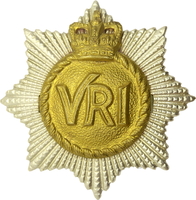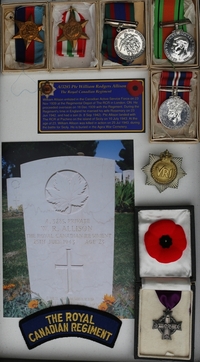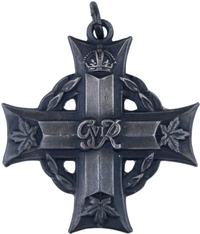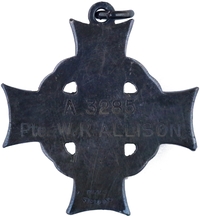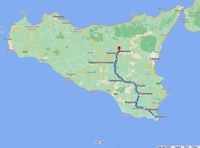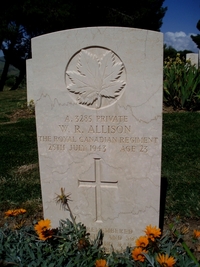
A3285 Pte William Rodgers Allison
The Royal Canadian Regiment
By: Capt (ret'd) Michael M. O'Leary, CD, The RCR
William Rodgers Allison was born in London, Ontario, on 13 Oct 1919. The Allison family, led by parents David (34) and Jane (33), can be found in the 1921 Canadian Census. There are eight children in the home in 1921; Ellen (13), David (8), Mary (7), Jean (5), Robert (4), James (3), William (1), and Shannon (1 mo.).
On 23 Nov 1939, Allison, a 20-year-old labourer, enlisted in the Canadian Active Service Force (C.A.S.F.) at the Regimental Depot of The Royal Canadian Regiment in London, Ontario. He was described was 6 feet 3/4-inches in height, weighing 134 pounds, with a 35-inch chest, fair physical development, a dark complexion, brown eyes, and dark brown hair. Allison was found fit for Category "A" although his dental fitness was noted as "requires deal of attention." Allison's religious denomination was Presbyterian. Giving his address on enlistment as 625 Lorne Ave., London, Ont., Allison's identified his father, Mr. David Allison, living at the same address as his next-of-kin. On enlisting for The RCR, Allison was given a service number from a number block allocated for the Regiment, A3285.
An Occupational History Form was completed on Allison when he enlisted. The form noted that he left school at the age of 17 after completing the 10th Grade. Allison was employed as a Clerk and Golf Pro Assistant at the London Hunt & Country Club where he had been employed for three years. Allison stated that he had no intention or desire to return to his prior employment after his service, but indicated that he might join his uncle's business as a scale inspector.
On 5 Nov 1939, The RCR was ordered to concentrate at Camp Valcartier in preparation to sail to Europe. Although Allison had no prior military experience, the urgency to prepare the Regiment for overseas at war strength meant that his training was going to be on the job. After some introductory training in London, Allison was taken on the strength of The RCR (C.A.S.F.) at Camp Valcartier, Quebec, on 1 Dec 1939.
Less than three weeks later, on 18 Dec 1939, Allison was struck off the strength of the C.A.S.F. (Canada) on embarkation at Halifax, N.S., and taken on the strength of the C.A.S.F. (Overseas) the following day. After waiting aboard ship in Bedford Basin for three days, the Regiment set sail on 21 Dec 1939 and made the Atlantic crossing aboard the hired military transport H.M.T. Almanzora, a Royal Mail liner. The RCR, with William Allison, disembarked at Gourock, Scotland, on 30 Dec 1939.
Although the details have not survived in his service record, Allison was charged on 30 May 1940 with being absent without leave. This was his first, but would not be his last unauthorized absence.
On 31 May 1940, Allison was struck off strength to No. 1 Infantry Base Depot, Aldershot. While at the Base Depot, and then No. 1 Canadian Infantry Holding Unit (C.I.H.U.), Bordon, after 18 Jun 1940, he would miss the Regiment's brief foray into France from 14 to 17 June.
Allison proceeded on leave 6 Aug 1940. Effective the following day he was promoted Acting Corporal, without pay, and ten days later on 17 Aug 1940 he received the pay to go with his new rank. On 23 Dec 1940, Allison's name came up for another leave period.
Allison proceeded on command, i.e., a temporary duty that did not require change of parent unit, to attend the Physical Training Course at Bordon. While on this course, he was attached to No. 3 C.I.H.U. for rations and quarters. He returned to the Regiment on 5 Feb 1941 from the P.T. Course and ceased to be attached to No. 3 C.I.H.U. Allison was attached for rations and quarters to No. 1 Canadian General Holding Unit (C.G.H.U.), Bordon from 7 Feb to 11 Mar 1941. Midway through this period away from the Regiment, on 18 Feb 1941, he reverted to his Permanent Grade of Private from Acting Corporal at own request.
Allison proceeded on leave again for seven days from 22-29 Apr 1941. He went on leave again in November for another seven days from 5-12 Nov 1941.
The day he started his November leave, Allison was back in front of his Company Commander on charge for away without leave. For being A.W.L. from 2359 hrs 4 Jan 1942 to 1000 hrs 5 Jan 1942 (10 hrs, 1 min), he was admonished and forfeited 1 days pay.
Allison's regular appearances on the leave lists showed up again on 11 Mar 1942 when he went on leave from 11 to 18 Mar 1942. Within a month of returning from this leave, Allison would demonstrate that he was not just sightseeing, or drinking, on his leave.
On 12 Apr 1942, Allison completed and submitted an Application for Permission to Marry. In addition to identifying his intended betrothed, the form required Allison to state his educational standing (2 years Commercial High), his employment prior to enlistment (Clerk in a Sports Shop, $15-20 per week), and his plans for employment after discharge (to carry on his father's business). The form also required the signature of his fiancee, 17-year-old Rosemarie Mildred Robinson, declaring that she was legally free to marry. Likely a result of Rosemarie's age, the form included a completed final section signed by the "Parent or Guardian of Proposed Wife." This was completed and signed by Rosemarie's mother, Alberta Robinson. Allison's application to marry received the favourable recommendation of his Commanding Officer, Lt.-Colonel T. Eric Snow. That support led to the granting of permission to marry by the Commander of the 1st Canadian Infantry Brigade, Brigadier R.F.L. Keller. Final notes on the form show that Allison's readiness to be married, as far as the Army was concerned, was reviewed by the Regiment's Chaplain (Capt. R.O. Wilkes), the Medical Officer (Capt. Ferguson), and the Paymaster (Capt. C.R. Hollingsworth). His application successful, Allison was granted permission to marry on or after 20 Jun 1942.
The postponement of the date he was permitted to marry becomes clear in Allison's service record. He proceeded back on course and on 19 Jun 1942, he completed the Regimental N.C.O.'s Course and qualified "Q II." Immediately after, he went on leave from 19 to 26 Jun 1942.
While on leave after his N.C.O.'s course, Allison married Miss Rosemarie Mildred Robinson at West Itchenor. The address of his wife as next of kin was The Black Bungalow, Itchenor, Sussex. Rosemarie's address would change to 17 Framfield Rd., Uckfield, Sussex, between October, 1942, and May, 1943, returning thereafter to Itchenor.
In updating his personal information with the Army, Allison completed a military will form on 21 Jul 1942. In this document he bequeathed all of his estate to his wife, Rosemarie Mildred Allison. Allison was on leave again from 12 to 19 Aug 1942.
A week after returning from his latest leave period, Allison was back on charge under Section 15(1) of the Army Act, absent without leave. He was charged and tried on 5 Sep 1942. The number of Allison's offences had started to catch up with him. This time he was awarded the punishment of seven days Confinement to Barracks (C.B.) with forfeiture of seven days' pay.
Three days after being confined to barracks, we find a possible reason why Allison was absent again. For the same reason, it's very possible that he was allowed out of barracks inside the seven day sentence. On 8 Sep 1942, William and Rosemarie Allison celebrated the birth of their son, Roger Kingsley Allison, at West Ichenor, Sussex.
Less than two weeks after the birth of his son, Allison demonstrated that he still had not found the motivations to meet timings. Charged again for absence on 17 Sep 1942, he again forfeited seven days and received another seven days C.B. Allison's latest offences didn't stop he from proceeding on leave for nine days in October (12-21 Oct 1942) and for another nine days in January, 1943 (4-13 Jan 1943).
On 18 Mar 1943, Allison was granted daily regimental pay of $1.50. Six weeks later, on 2 May 1943, he was appointed Acting Lance Corporal. He would not hold this rank for a full month. On 24 May 1943, Allison was once again charged with being A.W.L.. An absence of 15 hrs, 30 mins, resulted in his being reduced to Private and forfeiting one days' pay. The day after his charge, Allison was granted seven days compassionate leave until 1 Jun 1943. His service record provides no details of the reasons for this leave. On return from compassionate leave, Allison's file shows he was late again, with one more charge of A.W.L. on 3 Jun 1943 for which he received a forfeiture of one days' pay for 22 hours absent.
The Army's problem with Allison's regular absences was curtailed on 13 Jun 1943, when the Regiment boarded the ship Marnix Van St. Aldegonde at Faslane, Scotland. After an amphibious landing exercise and reboarding, the ship was at sea on 19 Jun 1943 when the senior naval officer in the convoy announced to all ships that "We are on our way to the Mediterranean to take part in the greatest combined operation ever attempted."
On sailing from Faslane, Allison and every other Royal Canadian on board, was taken on the strength of the Canadian Army (Central Mediterranean Force). After almost three weeks at sea, Allison disembarked on 10 Jul 1943 as The RCR assaulted the beaches at Pachino on the island of Sicily.
The regimental history, The Royal Canadian Regiment, Volume Two, 1933–1966, by G.R. Stevens (pub. 1967), describes the first actions of the Regiment on landing:
"First Objectives
"A and B Companies, after a two hour wait on deck, finally were slung overside. As had been expected the landing craft grounded on the sandbar; fortunately the water was shallow and everyone splashed safely to shore. Both companies were despatched inland without delay. They crossed stunted vineyards, with A Company heading for Maucini, B Company for the coastal defence battery. At the first of these objectives there was virtually no resistance but 24 prisoners were picked up. B Company passed through and closed up on the battery position which was under accurate fire from the monitors. Capt. Galloway sent back an urgent message, asking the guns to lift. When his platoons deployed to surround the position they found that the wire entanglements were of no account; the Bangalore torpedoes were jettisoned and the platoons stepped across the strands. The battery positions were empty but Sgt. Bougard, in examining dugouts, heard voices. He fired a shot, whereupon 38 Italians including three officers, trooped out. All were manifestly anxious to be through with the war. B Company moved on past the battery site to allow Lt. G.N.C. Campbell and his pioneers to disable the guns.
"Good Work By "A" Company
"C and D Companies now passed through, heading for Pachino airfield behind the town, which had fallen to 51st Highland Division. (The Pachino stationmaster was busily telephoning to his colleagues along the line. "Have no fear; be good to the Englishmen in funny hats; they are kind to our children and treat prisoners well") There was a certain amount of distant and inaccurate firing but C Company without difficulty cleared the eastern fringe of the airfield, picking up nearly one hundred prisoners. Whereupon Colonel Crowe ordered B and D companies to occupy the high ground to the north of the airstrip.
"Meanwhile, A Company continued on from Maucini until held up by a concrete strongpoint, very similar to the "pillboxes" of the First World War. Here the enemy resisted and part of the Company was pinned down; Pte. G.C. Hefford, the first battle casualty of the war, was killed. The subsequent action cannot be better described than in the proud words of Capt. Liddell's report.
"In the vicinity of the barrack huts on the south side of the hill the Company came under heavy fire from machine guns and rifles together with some shelling by howitzers. Movement by platoons as such was not possible so sections commenced to work forward independently. Ptes. Grigas, Gozds, Butler, Gorham, Gardner and Allison managed to reach the wire in front of the concrete machine gun emplacement. Pte. Gorham stood up and cut the wire while covered by the remainder of the party. They then passed through the gap and engaged the first gun position, forcing the crew to surrender. During this action Pte. Gozds was wounded in the shoulder. A medium machine gun position in line with the first was then engaged and captured. A third position was then taken on and silenced. In taking it Pte. Butler was killed while attacking with the bayonet.
"At this point wholesale surrendering began. Included in the captures were four howitzers (6" approximately) with large stores of ammunition, four medium machine guns, eight light machine guns, large numbers of rifles and over 200 prisoners."
"Never was the decentralization of leadership more superbly illustrated. Pte. Joseph Grigas was awarded the Distinguished Conduct Medal; Pte. J.W. Gardner, the Military Medal—the first decorations for gallantry bestowed on The Regiment in the Sicilian campaign."
The War Diary summary for July to December 1943, summarized the actions of Pte Grigas's section:
"Ptes Grigas, Gardner, Gozds, Butler and Allison who forced their way over the enemy wire, put two MG posts out of action and, by their aggressiveness, struck terror into the hearts of the Italian."
From the landing at Pachino, the placenames recorded for daily entries in the Regiment's War Diary chronicle the contested march inland: Pachino, Rosolini, Ragusa, Giarratana, Vizzini, Grammichele, Caltagirone, Valguernera, Assoro, Nissoria.
On 24 Jul 43, The RCR passed through Nissoria on the approach march to Agira. The Regiment was held up by the stiff resistance of the enemy on heights east of the town, blocking the way forward. Working against communication problems, Lieut.-Col. Crowe, the Commanding Officer, was caught in a German killing zone while trying to make contact with separated companies that continued to work their way forward. The C.O. and two of his signalers were killed that afternoon. As the day ended, three companies of the Regiment were in a defensive posture beyond the German blocking position. The following day, the Hastings & Prince Edward Regiment passed through to lead the advance toward Agira and The RCR withdrew to behind Nissoria to reorganize. The War Diary summarized the cost: "The rifle coys have all been able to extricate themselves, but during the fighting fairly heavy casualties have been suffered, about 15 killed and 30 wounded."
William Rodgers Allison was killed in action on 25 Jul 1943. He is buried in the Agira Canadian War Cemetery. Allison's entry in the cemetery's Register of Graves reads: ALLISON, Pte. William R., A.3285. The Royal Canadian Regt. 25th July, 1943. Age 23. Son of David and Jane Allison, of London, Ontario; husband of Rosemarie M. Allison, of London, Ontario. B, D, 187." The personalized memorial inscription at the base of Allison's gravestone reads: "Ever remembered, By his wife and son, Mother and dad, Sisters and brothers."
Rosemarie Allison was entitled to receive a War Service Gratuity after her husband's death. Calculated based on his length of service and rate of pay at the time of his death, she would receive a Gratuity of $867.49.
For his service in the Second World War, Allison was eligible to receive the 1939-45 Star, the Italy Star, the Defence Medal, the Canadian Volunteer Service Medal with Overseas Clasp, and the 1939-45 War Medal. These were confirmed in his service record on 29 May 1946. Allison's wife and mother received silver Memorial Crosses.
On 13 Mar 1947, the Adjutant-General's Director of Records forwarded to Allison's mother a photograph of his grave and temporary marker. The letter confirmed that Allison was buried in Agira Canadian Military Cemetery, grave 187, row D, plot B.
Pro Patria
Visit a randomly selected page in The O'Leary Collection (or reload for another choice):
- The O'Leary Collection; Medals of The Royal Canadian Regiment.
- Researching Canadian Soldiers of the First World War
- Researching The Royal Canadian Regiment
- The RCR in the First World War
- Badges of The RCR
- The Senior Subaltern
- The Minute Book (blog)
- Rogue Papers
- Tactical Primers
- The Regimental Library
- Battle Honours
- Perpetuation of the CEF
- A Miscellany
- Quotes
- The Frontenac Times
- Site Map
QUICK LINKS
The O'Leary Collection—Medals of The Royal Canadian Regiment
Newest additions:
![]()
![]() SB-12725 Private Henry "Hank" Ard
SB-12725 Private Henry "Hank" Ard ![]()
WIA at Hill 187, Died of Wounds in Japan
![]()
![]() 2355331 Lance Corporal Albert Lorking
2355331 Lance Corporal Albert Lorking
Wounded in action, later a War Amps representative.
![]()
![]() 4334 / 477996 Pte Isaac Hamilton Wilcox
4334 / 477996 Pte Isaac Hamilton Wilcox
Permanent Force, South Africa, and C.E.F.
![]()
![]() 477019 Private Harold Ashcroft
477019 Private Harold Ashcroft
Transferred to the Tunnelers.
![]()
![]() 734231 Private Clark D. Thompson
734231 Private Clark D. Thompson ![]()
The older Thompson brother, killed in action.
![]()
![]() 733849 Private Norman Parker Thompson
733849 Private Norman Parker Thompson
The younger Thompson brother; post-war service in the Special Guard.
![]()
![]()
![]() A305 / 400305 Private Andrew Walker
A305 / 400305 Private Andrew Walker ![]()
"Previously reported Wounded, now Killed in Action."
![]()
![]() 823298 Pte Thomas Patrick Steele, M.M.
823298 Pte Thomas Patrick Steele, M.M. ![]()
… for gallant conduct in the field …
![]()
![]() P13066 Sergeant Harold Thompson
P13066 Sergeant Harold Thompson
Instrumental Soloist for over 20 years of Canadian Army service.
![]()
![]() 9609 / 477728 Private Albert Edward Piper
9609 / 477728 Private Albert Edward Piper
"Arrived from England as a STOWAWAY …"
